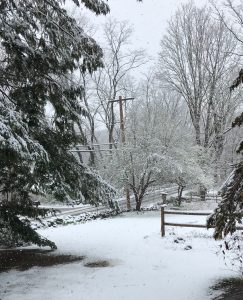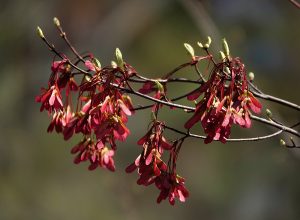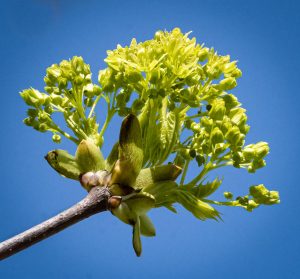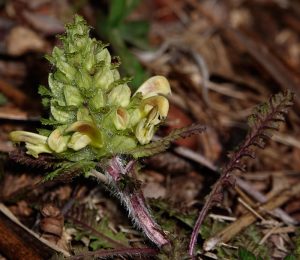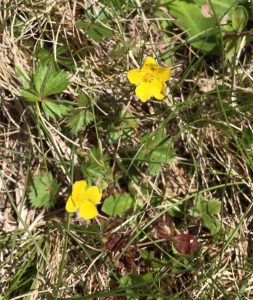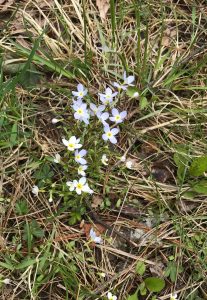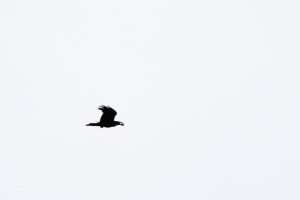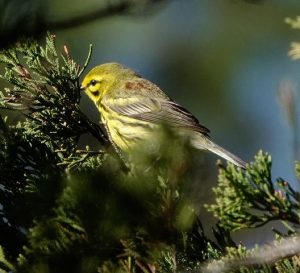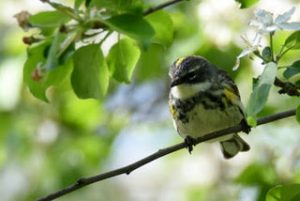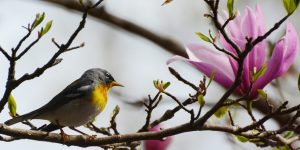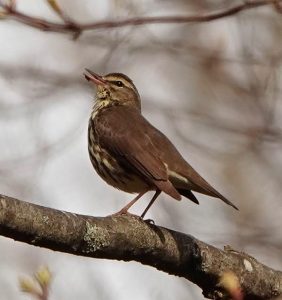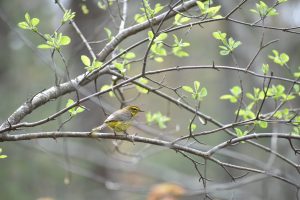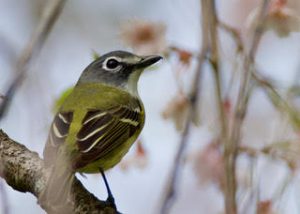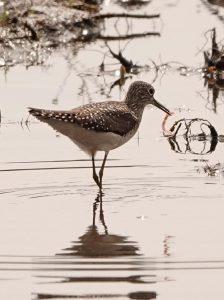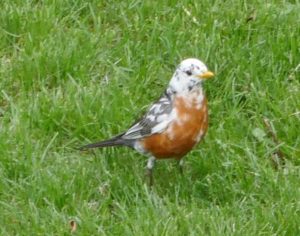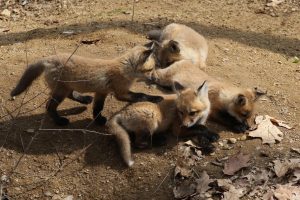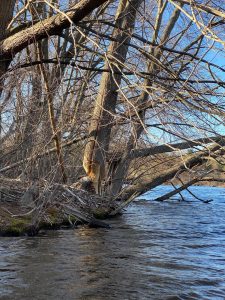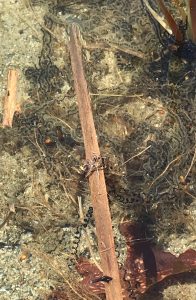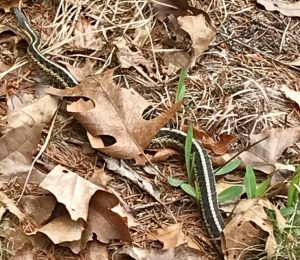Written by Gwyn Loud for the Lincoln Land Conservation Trust. She welcomes your sightings and questions at 781-259-8690 or gwynloud555@gmail.com.
Late-breaking sighting: early in the morning on May 12 a bear was seen in the Boyce Field area of Drumlin Farm.
April weather exhibited its usual vagaries of warm and cold days, even bringing enough snow on April 16 for the plows to appear. May has started off cool and wet; rain was much needed and has raised the water in ponds and streams, although we are still behind the normal rainfall average. The cool spring seemed to make flowers such as daffodils last longer than usual, and now, after the rain, lawns are bright green and flowering trees and shrubs are spectacular. Most deciduous trees are leafing out, and beautiful red or green samaras (seeds) hang from red and sugar maples. Norway maples, flowering later than other maples, displayed their yellow-green flowers, and now the oaks are in flower. Among the wildflowers to observe in the woods are wood anemone, sessile-leaved bellwort, jack-in-the-pulpit, and lady’s slippers. Canada mayflower (aka wild lily-of-the valley) carpets the woodland floor, and along streams, clumps of marsh marigolds add yellow beauty to the scene. Both low bush and high bush blueberries are in bloom, attracting pollinators, and are harbingers of berries to come. In more open areas one can find winter cress, wood betony, bluets, ground ivy, and dandelions, which are everywhere. Garlic mustard is in flower and it is important to pull this invasive plant before it sets seeds. Some will continue to flower into June, so it pays to recheck areas where you have pulled.
Avian migrants have been arriving gradually over the last few weeks. Some, such as ruby-crowned kinglets and most of the wood warblers, are just passing through to breed farther north but others settle here to nest and raise young. Ruby-throated hummingbirds turned up at sugar-water feeders as early as April 30, and rose-breasted grosbeaks are singing and preparing to breed. Many people report bluebirds nesting in boxes, with young already hatched. Baltimore orioles are back, and some people have luck attracting them with hanging orange halves. The orioles make unusual nests, using plant fibers to make soft bags hanging below branches, often quite high in a tree. House wrens are chattering constantly (driving some homeowners crazy!) and the males are busy making several nests of sticks in bird houses, of which the female will select one. House finches may be nesting in your old Christmas wreath, Eastern phoebes on your porch, and barn swallows in your barn. Many of our common birds nest in tree cavities, including all the woodpeckers, which drill their own holes. Birds such as chickadees, nuthatches, and titmice can enlarge existing holes in soft wood, and larger birds such as wood ducks and screech owls also use existing cavities. On ponds, watch for Canada geese with their goslings and mute swans with cygnets.
Spring is the season when one is most likely to find a baby bird on the ground or perhaps what seems to be an abandoned baby mammal. In nearly all cases it is best to leave it alone as, unknown to us, the parent is probably nearby, well aware of the situation and will take care of it. Rabbits especially stay away from their young so as not to attract predators.
Common ravens are nesting in Lincoln; participants on a recent LLCT bird walk watched adults going back and forth to a distant nest carrying chicken eggs, probably stolen from free-range CCF chickens! On the same walk we could see a great blue heron nest in a dead tree along the stream south of St. Anne’s. Other notable recent bird sightings include an orchard oriole, warblers such as palm, yellow, yellow-rumped (numerous), black-throated green, black-throated blue, Northern parula, American redstart, black-and white, common yellow-throat, ovenbird, prairie, and Northern waterthrush. Blue-headed and warbling vireos are back, with red-eyed vireos expected any day. Double-crested cormorants have visited a couple of ponds and up to nineteen buffleheads were on Valley Pond. Osprey are back fishing in Farrar Pond, a solitary sandpiper was feeding in a puddle in the Ricci Fields, and bobolinks have returned to Farm Meadow, where they have nested successfully for years. At Drumlin Farm birders reported sightings of an American pipit, an American kestrel, a yellow-bellied sapsucker, red-breasted nuthatches, a fish crow, and Savannah sparrows. A walker was surprised to flush an American woodcock from the edge of North Baker Bridge Field; it is probably nesting there. A leucistic robin is living near Canaan Drive for the second year. Leucism, the result of genetic mutation, causes a partial loss of pigment, sometimes making the coloration patchy.
Beavers are very busy in many parts of Lincoln and “beaver deceivers” are put in place to allow the beavers to live but prevent them from damming streams to create flooding conditions, as has been happening in the brook flowing to the Mt. Misery ponds south of St. Anne’s. I am always impressed to see what large trees beavers can take down, just with their teeth! Red fox kits are now out of their dens; as Mary Holland writes,” By the time we see Red Fox kits, much has happened in their young lives. They’ve gained sight, a new coat, a set of teeth, the introduction of solid food, and most importantly, hierarchy has been established. Peace now reigns and we get to enjoy the kits’ playful antics as they are introduced to the world above ground.” Raccoons are looking for den sites and will give births to four or five young, not to emerge until June or July.
A Baker Bridge Rd. resident reports, “Our new neighbor is a very aggressive red squirrel. We watched him on the weekend defending the sunflower seeds on our patio from Blue Jays and grey squirrels. He even chased the former when they were perched in the nearby yew bush”. Other mammal sightings include woodchucks (ground hogs), coyotes, white-tailed deer, and numerous chipmunks.
American toads have been giving their high thin trills to attract mates, and have laid their spiral strings of thousands of eggs in shallow water. Gray tree frogs are starting to call, soon to be followed by green frogs, and finally, bull frogs. Listen for the snoring call of the pickerel frogs. As for reptiles, painted turtles are very visible sunning on logs at pond edges and we should all be watching for turtles crossing roads as they search for sandy spots in which to lay eggs. A Conservation Department staff member wrote, “There is a snapping turtle that walks across the Town Hall parking lot every spring (presumably heading to Beaver Pond?), then he (or she!) will head back across Sandy Pond Rd. later in the season for Flints Pond, then crosses back again into Smith-Andover in late summer. I saw it making its Town Hall parking lot crossing this Monday. It has a distinctive crack across its shell that helps us identify it every year! It’s a huge specimen.”
If you encounter a snapping turtle on the road, do not pick it up by the tail but use a stick to gently nudge it across in the direction it is headed. Do not get near its head as it can bite! Snapping turtles, which mature at 8-10 years, dig a hole in well-drained soil and lay 20-40 eggs the size of ping-pong balls. The female then returns to the water, leaving the young to hatch in the fall, although about 90% of the eggs are found and eaten by raccoons, skunks, or crows. Garter snakes, common and harmless, are easily seen as they sun themselves. Unlike most snakes, which are oviparous (lay eggs), garter snakes are viviparous, meaning they bear live young. Garter snakes are mating now and the females will carry from 3-85 young until they are born between July and September.
Insects abound as the weather is warms. Watch for early butterflies such as little blue ones, either Eastern-tailed blues or spring azures. Many of us have become much more aware of wild bees, now that we are learning the importance of native pollinators and the plants that attract them.
Finally, hopefully the skies will be clear on May 26, allowing us to appreciate the full Flower Moon, the second supermoon of the year and the full moon closet to Earth in 2021. It also coincides with a lunar eclipse, though the total eclipse will only be total viewed from western North America.
Pertinent links:
https://www.massaudubon.org/learn/nature-wildlife/birds/baby-birds-out-of-the-nest?
https://srelherp.uga.edu/turtles/cheser.htm
https://www.almanac.com/content/full-moon-may


